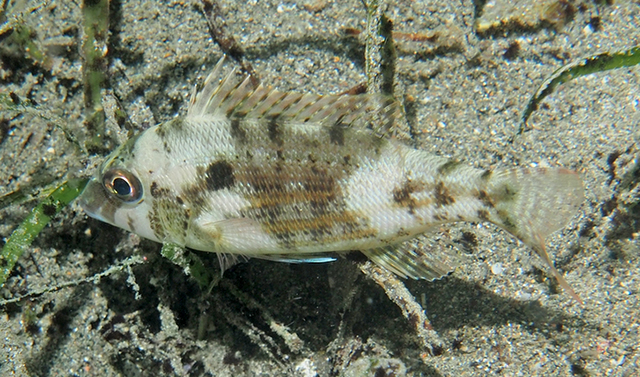| Lethrinidae (Emperors or scavengers), subfamily: Lethrininae |
| 25 cm TL (male/unsexed); max. reported age: 7 years |
|
reef-associated; brackish; marine; depth range 5 - 25 m, non-migratory |
| Indo-West Pacific: Indonesia (including eastern Indian Ocean side), northwestern Australia, Philippines, southern Japan, Papua New Guinea and the Caroline Islands. This species has long been recognized as Lethrinus nematacanthus and the name Lethrinus genivittatus misassociated with many other species. |
|
Dorsal spines (total): 10-10; Dorsal soft rays (total): 9-9; Anal spines: 3-3; Anal soft rays: 8-8. The only Lethrinus with its 2nd dorsal spine the longest. The inner surface of the pectoral fin may be scaleless, partially covered with scales or densely covered with scales. Body color is tan or brown on the upper sides, white on the lower sides, with three tan or brown stripes. The sides often have scattered irregular black oblique bars and a square black blotch above the pectoral fin and bordering below the lateral line. The head is brown or tan sometimes with several broad, somewhat indistinct vertical and oblique bands (these bands are sometimes composed of fine reticulations). The fins are pale, speckled with small white blotches. |
| Solitary or in groups (Ref. 90102). Occurs over shallow sandy and seagrass beds, in mangrove swamps, lagoons, channels and outer reef slopes. May enter rivers. Feeds on crustaceans and small fishes. A protogynous hermaphrodite (Ref. 55367). A protracted spawning peak from July to December is recorded in New Caledonia. Smaller and more numerous females than males have been confirmed in Australian populations. Marketed fresh (Ref. 9775). |
|
Least Concern (LC); Date assessed: 04 February 2009 Ref. (130435)
|
| harmless |
Source and more info: www.fishbase.org. For personal, classroom, and other internal use only. Not for publication.
